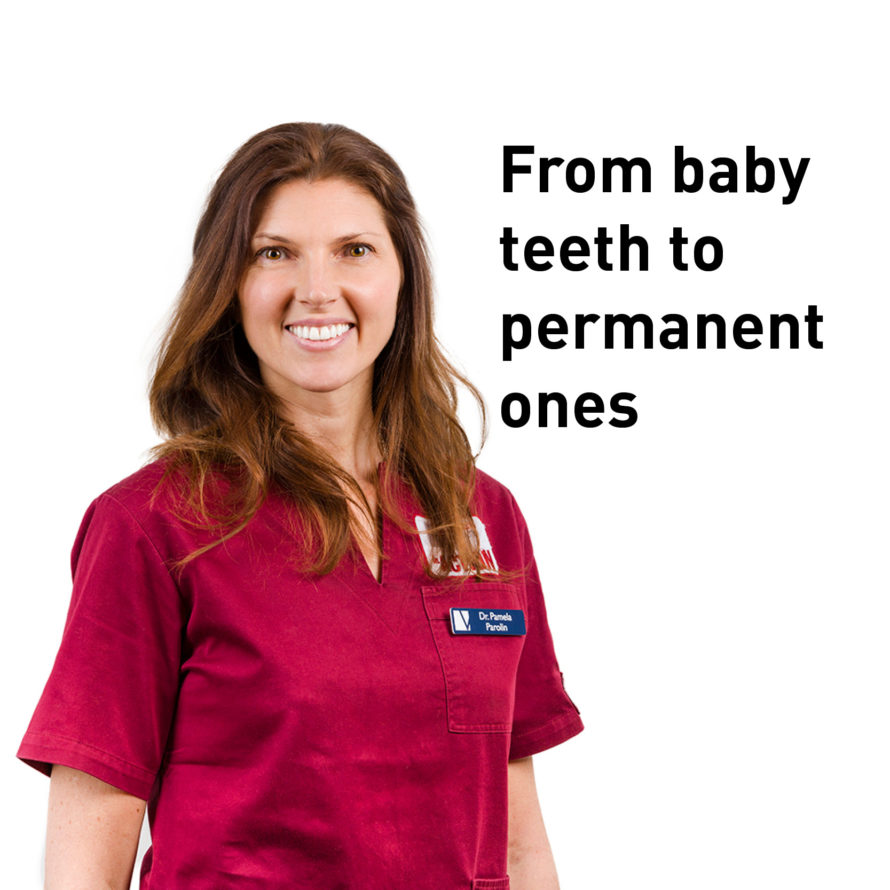
Today with Doctor Pamela Parolin – pediatric dentist of Centro Ortodontico Vicentino – we will talk about dental development and growth in children, as it is important to understand how dentition occurs so that both kids and parents are able to manage a difficult moment.
“Why is my son nervous, has a fever and a lot of saliva?… could it be caused by a dental problem?”
“My daughter is one and still has no teeth… should I worry?”
Many parents ask themselves these questions during the first year of age.

Doctor, how do baby teeth grow?
Between the age of 6 months and 2 and a half years baby teeth (deciduous teeth) form (20 teeth in total). The first permanent teeth to appear are lower incisors (at the age of 5-6 months), followed by upper and lateral incisors (9-12 months). Then canines come out (16-23 months), first molars (14-23 months) and second molars (25-33 months).
Eruption order and time can vary, so sometimes the first tooth comes out from the gum during the first months of age or even after one year. Do not worry!
When kids feel there is something new inside their mouth, their gums often feel uncomfortable and can get red and inflamed. Kids can easily become grumpy, lose lots of saliva and try to eat anything they find.
More controversial is the association with fever and diarrhea, maybe also linked to changes in nutrition and life habits which kids have to face during the same period of time.
In such cases we should give them soft and cold toys to play with, especially studied to be chewed and kept inside the mouth, or we should use a clean gauze soaked in cold water. This will decrease the annoyed feeling affecting gums and give them relief.
What if there is room between one tooth and the other? Great! This means that permanent teeth will be much bigger than their deciduous equivalents and maybe there will be less chances of arch crowding.
What about the loss of baby teeth?
After a short break at the age of six, everything starts again!
Lower incisors are the first ones to fall out. This makes kids very happy as they can put together their first savings. They are substituted by permanent incisors followed by first permanent molars: the big teeth with deep furrows at the end of the arch.
Be careful: these teeth are very hard to keep clean and more subject to the risk of early tooth decays. In such cases, the pediatric dentist could suggest dental sealants: very thin but extremely resistant resins which are applied to cuspid and bicuspid furrows and are used to prevent tooth decays.
Then lateral incisors erupt (7-9 years), followed by canines (9-12 years), first bicuspids (10-12 years) and second bicuspids (10-13 years). At the age of 12-13 also second molars erupt.
Do things always go smoothly?
Of course the answer is “Not always!”.
There are many variables to be taken into consideration. Among these is the case of a tooth in second row: the deciduous tooth does not leave its place and the permanent one is forced to erupt somewhere else, often on the inside.
If the baby tooth does not give any signs of imminent retreat, the pediatric dentist extracts it gently. The tongue push is often strong enough to bring back the permanent tooth in the arch.
Sometimes permanent teeth arrive late. We wait and wait, but nothing happens…
I suggest you to go to the pediatric dentist who can recommend a Panorex (if it has not already been done at the age of 6-7) which can highlight the presence of any supernumerary teeth (extra teeth) which obstruct the normal path of permanent ones or even erode roots of neighboring ones.
Some other times the tooth is held in the bone.
In such cases, first a surgical and then an orthodontic approach (appliance) can solve the problem.
What if the tooth is not there? This is called agenesis.
It can also happen that the baby tooth remains in infraocclusion: this means it does not fall and it stays in a lower position compared to the rest of the teeth which swing or fall and are substituted by permanent ones. As time passes, these can even grow and tilt so much that they climb over the baby tooth which is thus trapped.
It is therefore important to not underestimate the wrong position of baby teeth, as this can cause crowdings or a disorder of the normal positioning of permanent teeth in the arch.
Doctor, do decayed baby teeth need to be treated?
A tooth decay can cause pain and difficulties in chewing and can reach the pulp and cause an abscess. It is therefore necessary to rebuild it with fillings made of composite resin.
It is important to always treat tooth decays, especially those affecting deciduous molars. This is to avoid the early loss of baby teeth which, by leaving an empty space, would invite neighboring teeth to move and fill it, thus taking it away from the future permanent tooth.
If the tooth is too decayed and impossible to be rebuilt, it has to be extracted and we should consider the chance of using a dental space maintainer.
My advice is to always prevent tooth decays! How?
By brushing teeth correctly after each meal, using dental floss, fluorine toothpastes, paying attention to nutrition, doing regular dental check-ups and with the support of specific sealants and protective dental lacquers if necessary.


